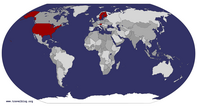Advertisement
Published: November 25th 2007

 Northern Lights
Northern Lights
I hope I get a chance to see them up there in Lapland next week!It's starting, Christmas is in the air. I was shopping with Emma and Leena in Turku on Friday, and the walking strip was brightly lit with thousands of christmas lights, and the windows in Stockmanns were full of Christmas scenes. The air was crisp and cold, but felt fantastic to breath. Later in the night, as we were leaving sleet started to fall. The small cold pieces of ice hit our faces and stung. By the time we got to the car we were soaking wet but happy. Christmas music was playing in all the shops that day, English and finnish. There were a couple street performers adding to the scene, playing their accordians and saxophones. It was fantastic. Then last night Marru and her friend Rele took me to the movie theatre in Turku to see Joulutarina. Joulutarina is a new finnish movie about the origin of Santa Clause. There were no subtitiles, but it has become one of my favorite movies, it was so moving. It was filmed in Lapland so you can just imagine the wonderful scenery. It was giving a five star rating so I am hoping it will be given English subtitles and brought to America

 Christmas Spirit
Christmas Spirit
It was everywhere.some time soon!!! Also to add to this Christmas Spirit, I am going to Lapland on friday with Rotary for the Lapland tour! It is on my birthday! I can't believe I will be spending my 17th birthday up in LAPLAND!!! with Joulupuki (Santa Clause). I am so excited. So here is a wonderful article my mother sent to me today about letter to Santa Clause. I know it is rather long, but it is totally worth the read! Hope everyone is as excited about Christmas this year as I am! Happy Holidays!!!
DEAR SANTA CLAUS
Santa Claus in Finnish Lapland receives hundreds of
thousands of letters from all corners of the world
Sisko Ylimartimo
Years ago, when I was a little girl, my father told me how to write to Santa Claus: leave your letter on the windowsill on the porch and Santa's invisible elves come and fetch it. How excited I was when the letter had disappeared by the morning!
Children still write to Santa Claus today, but it is no longer necessary to leave the letter by the porch window. Children can drop them into an ordinary post box and

 Turussa! (in Turku!)
Turussa! (in Turku!)
What lovely decorations!the letters are delivered to their destination. English children write to Santa Claus or Father Christmas, Italian to Babbo Natale, German to Weichnachtsmann, and French to Père Noël. Santa Claus' address may vary: it can be Lapland, Korvatunturi or Joulumaa (Christmas Land) or Festive Street, Gnome Street or Reindeer Street, as well as the North Pole, Greenland or the Arctic Circle. There have even been times when someone has confused the cardinal points and addressed the letter to the South Pole.
But there is no need to worry: Santa Claus receives all the letters, no matter where they come from. They arrive at Santa Claus Main Post Office, located on the Arctic Circle in Lapland, near the city of Rovaniemi. Considering that Santa receives 300,000 letters annually, sorting out the addresses keeps Santa's elves extremely busy. Since many letters are written by more than one person, a cautious estimate is that some 600,000 children and adults write to Santa Claus, says 'the Post Office Elf' Taina Ollila from the Santa Claus Main Post Office. If there is an address on the envelope and the writer tells some personal details, in other words, the letter is more than a mere

 Stockmann's Windows
Stockmann's Windows
Every year it is known that Stockmanns has the best Christmas scenes in their windows!material wish list for Christmas, the helpful elves will mail a letter from Santa Claus to the sender.
The Arctic Phenomenon Project studies letters
The Faculty of Art and Design of the University of Lapland is engaged in a project entitled the Arctic Phenomenon, one part of which is studying letters written to Santa Claus. The Christmas letter project seeks to chart the images the writers have of Lapland, winter, Christmas, and Santa Claus. The aim is to utilise the results in designing the Lapland Christmas product, says Tuula Rintala-Gardin, the Director of the Lapland Centre of Expertise for the Experience Industry. A proposal on Christmas-related content production has recently been published.
The aim of the Arctic Phenomenon research project on Christmas letters is to create a system to enable the rational, practical, and systematic storage and study of letters. The system would also make it possible to utilise the material, for example, in designing different performance and exhibition environments.
In spring 2001, the University of Lapland established a research group headed by the author of this article, which studies the letters and makes use of the content in individual study projects. A network application on the
letter material for research is also under preparation. The project will end in August 2002. The findings will be related to the development of Christmas in Lapland as a comprehensive Christmas product since some 200 charter flights bring Christmas-smit-ten tourists, ranging from children to the elderly, to Lapland.
A variety of wishes
We can distinguish certain basic types among the hundreds of thousands of letters written to Santa. There are mere wish lists containing the desired Christmas presents. There are usually some half dozen items per list, save that one Excel document with a total of 154 wishes! The desired items seem quite global: girls' ideal presents are Barbie dolls whereas boys want to have Pokemons. Lego bricks are also popular. Some want to have the most recent Harry Potter book. In order to prevent Santa Claus from having any misunderstanding about the desired present, some letters are adorned with items cut from toy catalogues.
The second letter type does not include wishes for material things. Instead, the letters contain a polite Christmas greeting and wish for the well being of Santa Claus, possibly his wife and elves as well. The writer or his or her parents may also tell that the writer has been very good all year, or at least has tried. An entire class of German school children sent a letter on the theme 'Was man nicht kaufen kann'. They wished for things money cannot buy, such as love, joy, happiness, health, longevity, friends, less pollution and, above all, peace on earth.
English children may tell Santa Claus that the chimney has just recently been swept and that there is something in the refrigerator for Santa Claus to eat and drink. In addition, there is an extra bunch of carrots for Rudolf and the other reindeer. Santa Claus also receives a multitude of kisses sent by mail, the rows of XXXX's are sometimes so lengthy and numerous that one cannot help thinking that Santa Clause must be the most kissed person in the whole world!
Many adults also write to Santa Claus. A Japanese couple wished that Santa Claus would answer their letter so that they could tell their yet unborn child that Santa Claus really exists. A 15-years old boy wrote that although he does not actually believe in Santa Claus, he has always received such nice presents that he really has to think of Santa Claus as a real person.
Many parents, grandparents, and teachers may unburden their hearts to Santa Claus. In addition to joyful things, many children write about their sorrows and fears. For example, the recent war in Bosnia left a significant mark on children's letters. One cannot but imagine how grim a shadow the terrorist attack on the World Trade Centre has cast on the world and letters of little children.
Dummies, drawings, and sacramental bread
I have noticed that in many letters there are at least a couple of things that have remained unchanged since my childhood: paper torn out of an ordinary school exercise book and the text written in pencil. Letters are also often written in felt-tipped pen; the most diligent letter writers change colour with each word. Texts printed on a computer are also commonplace. Why does it seem though that the most genuine letters are written in slightly shaky handwriting? One of the rarities is a letter written on birch bark sent by two Polish boys. Their letter is framed and hangs on the Santa Claus Post Office wall.
Many writers send more than a letter. At the Santa Claus Post Office, there is a large, transparent jug full of dummies; a testimony to giving up sucking the dummy. Adults from Catholic countries often enclose rosaries and sacramental bread. There are photographs of smiling children and their families. One Russian artist sent a beautiful book describing her own artwork. A letter from Italy contained a copy of the story of Babbo Natale. Taina Ollilla from the Post Office tells that Santa Claus receives loads of woollen socks and cuddly toys.
Not to mention the abundance of lovely drawings which would easily fill the exhibition space of many galleries! Often entire kindergartens and school classes have drawn and worked at their hobbies depicting their images of Christmas or fairy tales. Japanese children sometimes send letters containing many pages with skilful origami work. Santa Claus with his white beard and red outfit accompanied by his reindeer is naturally the most popular theme in drawings. Decorated Christmas trees are also very often depicted in the drawings.
Letters make Santa Claus happy
Santa Claus himself is greatly interested in the image children have of Lapland, Santa Claus, reindeer, and everything related to Christmas, for example, the decoration and festive traditions of different countries. He is also interested in seeing the way children of different ages use colours and how they depict objects and people.
The letters usually make nice reading, but sometimes they contain a sad undertone. Santa Claus is deeply moved by the genuine and direct way of encountering sorrow caused by, for example, the death of someone close. Santa Clause often ponders how adults have developed techniques to evade difficult and painful issues and refrain from talking about them, whereas a child asks directly "Why?"
It warms Santa Claus' heart when adults wish their children and friends sometimes even people they do not know a good life, happiness, and a better future. Personally Santa Claus is very happy when he notices that adults have not lost their small child within, the one we all possess.
Diving into the realm depicted in Santa's letters is a profound mental experience even for a researcher. I sit on the study floor alone, surrounded by the yellow post boxes from the Post Office, overflowing with letters and drawings. I read new wishes and greetings to Santa Claus. Shaky handwriting makes the chilly stonewalls of the room disappear and I slide back to my own childhood.
In the darkness of a December evening, I have placed my letter by the windowsill on the porch. After a while my father says that I can go and check whether Santa's elf has fetched my letters. The windowsill is empty. I scrape ice from the window and keep looking out. The snow is untouched. The child within me relives the miracle of Christmas.
P.S. Santa Claus sends his warmest greetings to the readers of Universitas Helsingiensis and wishes everyone a Merry Christmas and a Happy New Year!
The author of the article is a Doctor of Fine Arts at the University of Lapland. ß
Advertisement
Tot: 0.065s; Tpl: 0.012s; cc: 10; qc: 31; dbt: 0.0356s; 1; m:domysql w:travelblog (10.17.0.13); sld: 1;
; mem: 1.1mb









